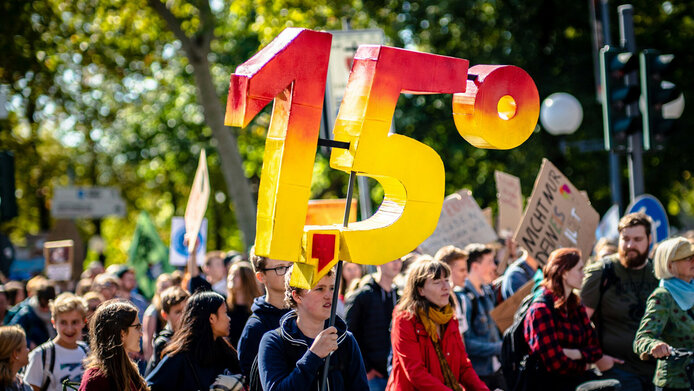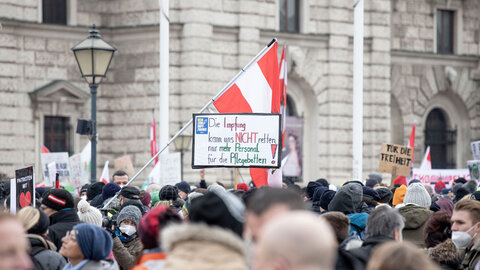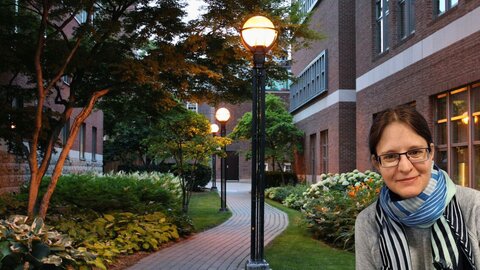Questionable signals from the EU Commission regarding 2040 climate targets

Global efforts for a significant and sustainable reduction of CO2 emissions are confronted by resistance of a social, political and economic nature. The longer we wait, however, the more drastic will climate protection measures have to be later on. With rapid and effective action becoming more unrealistic, the notion of so-called negative emissions surges to the fore. This notion centers on technologies and targeted interventions in nature that are expected to help remove excess CO2 from the atmosphere. One must be aware, however, that the majority of these carbon removal technologies are still in an experimental phase and far from economic viability.
There is a risk of these technological approaches triggering exaggerated hopes, purporting to offer a simpler solution and ultimately delaying effective climate protection. Alina Brad from the Department of Political Science at the University of Vienna and her colleagues analyze how climate policy strategies come about, and they explore the question of how expectations of removal technologies are reflected in these policies. Do they actually slow down measures to reduce greenhouse gas emissions – and if so, how?
Political scientist Alina Brad is analyzing the EU's climate targets. She is interested in possible delaying effects in climate protection that could occur due to excessive expectations in technological solutions.
Researchers have been working for decades on carbon removal technologies that can reduce carbon levels in the atmosphere and mitigate the climate crisis. To what extent are these technologies already applied in practice?
Alina Brad: Although the technologies do exist and are already doing their job in practice, the problem in this context is one of scale, i.e. expanding from pilot projects to widespread use. In order to achieve the Paris climate targets, there are plans for the use of so-called new methods of carbon extraction. These include the cultivation of biomass, which is then burned to generate energy. The resulting CO2 is then captured and injected into the ground or put to new uses in industry. Another approach foresees specially produced biochar, which stores CO2, to be incorporated in agricultural soils, for example. Other technologies go as far as to capture CO2 directly from the atmosphere. Then there are strategies based on natural processes in which more CO2 is to be absorbed by rocks or in oceans.
However, the use of all these methods is still negligible today and and is far from meeting the targets set out in the scenarios for achieving the Paris climate goals. Some of these scenarios envisage a total volume of 1,100 gigatons of CO2 to be captured by the year 2100. According to the latest Carbon Removal Report, the bulk of the 2.2 gigatons currently removed from the atmosphere annually will be achieved through conventional measures such as afforestation and reforestation. Their future potential is limited, however, whilst only 0.1 percent of the removal is currently achieved with the help of new methods.
What is the problem with large-scale use?
Brad: The cost of removing CO2 using the new methods is between 100 and 500 euros per ton, whereas, in European emissions trading, the emitting of one ton recently cost between 60 and 80 euros. In order to make larger use of the new methods economically viable, these amounts would have to come much closer together. However, the problem can't be reduced to a price issue alone. Even among researchers there are controversial debates about just how quickly large-scale use can be achieved. In addition to the assessment of technological and economic scalability, it is also a question of what social and political factors are taken into account. These include, for example, the possible negative consequences of large-scale biomass cultivation – from loss of biodiversity to changes in land use.
At the same time, it's still not clear whether it is even possible to capture the quantities of carbon required in keeping with climate models, since estimates of the potential also diverge in various model calculations. The only things that seem clear is that priority must be given to reducing emissions at source and that the spectrum of removal technologies implemented must be very broad in order to spread the risk.
In your project you are looking at the consequences of the anticipated removal solution in the here and now. Many researchers fear that the necessary reduction in emissions will be slowed down because people believe in a future technical solution. How may such expectations be reflected by political and economic mechanisms?
Brad: Empirical research on this issue is still in its infancy. One important factor is using models to calculate various climate protection scenarios. Negative emissions from CO2 removal technologies were taken into account for the first time over ten years ago, because the targets seemed almost impossible to achieve without them. The quantities of these negative emissions increased over the years because the speed of the transformation towards climate neutrality was far too slow. To put it bluntly: by removal technologies being taken into account in models, politicians were increasingly led to believe that the climate targets could still be achieved without far-reaching and rapid action.
In concrete terms, you are investigating the influence of negative emissions technologies on EU climate policy. What is your approach?
Brad: My research focuses on the political formulation of climate targets. Using a method called process tracing, I observe the underlying political decision-making processes and the relevant influencing factors as closely as possible. I work a bit like a detective, getting closer to the underlying connections step by step. In the 2040 EU climate targets, for instance, emissions reduction and CO2 removal were not listed separately after a public consultation process, although a broad alliance of scientists and civil society stakeholders consider this to be crucial in order to prevent delaying effects. In a recent study, we were able to show that the EU Commission did this because they wanted to imply that there is some flexibility: it somehow suggested that the climate targets could perhaps also be achieved with large-scale CO2 removal – and that drastic emission reductions are not set in stone.
The political decision-makers by no means want to delay climate measures, but rather maintain a comparatively ambitious climate target despite growing resistance. Our analysis is based on the statements from the consultation process and other EU documents, including leaks of earlier versions of the target wording, as well as expert interviews with policy advisors and representatives of NGOs and other civil society organizations.
Austria wants to allow carbon storage, i.e. the injection of carbon underground, which is currently prohibited here. Could this step also lead to a more lax approach to emission reduction targets?
Brad: That depends. In Austria, it was decided in the context of a carbon management strategy that the ban should be lifted. Due to the involvement of a scientific advisory board, very good groundwork was done in the development of the strategy. Austria is now one of the few countries internationally to have introduced a definition of “hard to abate” emissions. These “hard to abate” CO2 emissions are produced by sectors such as the cement and steel industries or agriculture. As long as this definition is kept as narrow as possible, the risk of delaying climate protection efforts can at least be minimized. Austria's capacities for CO2 storage in the ground are limited, and it makes sense to give access to those sectors that have no alternatives for their emission-intensive processes. The question of priority setting is central in this context – and I hope that Austria chooses to be a trailblazer with a narrow definition of “hard to abate” emissions.
Rearmament, the rise of right-wing parties and the tariff crisis triggered by the USA: how long can the EU maintain its ambitious climate policy in the face of these new problems?
Brad: A setback in climate policy has been observable since 2022. It was triggered by the energy crisis caused by the war in Ukraine. Add to this the fact that right-wing and extreme right-wing parties have now become stronger in the EU elections. They are pushing for abandoning climate protection measures, which puts pressure on the European Green Deal. While the Commission is still sticking to its climate target, we can observe that important regulations are being watered down – such as requirements for phasing out the combustion engine, the Supply Chain Act or corporate sustainability reporting requirements.
In the meantime, the EU is no longer a trailblazer in green technologies. Europe has been overtaken by China, which is investing heavily in this area – for instance in the field of electromobility. Europe needs to catch up. The EU is still defending its supremacy in the policy arena, for example when it comes to creating favorable framework conditions for climate protection or in the development of innovative political instruments. Despite all the new problems, it is essential for us not to lose sight of climate protection in the long term.
Do the various social crises make it more likely that people will expect a solution to the climate problem to be supplied mainly by removal technology?
Brad: First of all, it's important to note that there has always been a focus on technical solutions. It was a trademark of the climate debate from the very beginning. A more recent development sees conservative forces no longer being so strongly involved in denying man-made climate change. Instead, they now want to see it as a purely technical issue that does not require any social changes. However, this does not offer an actual solution, but merely shifts the problem – just think of the social and ecological consequences of lithium mining in the Global South. Technological development is, of course, essential for transformation. But it is at least as important to rethink social infrastructures and routines such as the mobility system. At the same time, the concerns of citizens must be heard and incorporated into political processes – something that happens much too rarely at present.
Personal details
Alina Brad is a Senior Scientist at the Department of Political Science at the University of Vienna with a research focus on international environmental, climate and resource policy, negative emissions and social processes in land use change. Previous stations in her career include the University of Bogor in Indonesia, the Leibniz Institute for Research on Society and Space in Erkner, Germany, and the Center for Sustainability Studies (LUCSUS) at Lund University in Sweden. The project “Negative emissions technologies in EU climate policy”, is set to run from 2023 until 2027 and receives EUR 340,000 in funding from the Austrian Science Fund FWF under its Elise Richter Program.
Studies
Carbon removal technologies can’t replace climate protection
The EU Commission has set ambitious climate protection targets. Greenhouse gas emissions are to be reduced by 90% by 2040 compared to 1990 levels. Austria wants to be climate neutral by that time.
The mix of measures includes technologies for removing and storing greenhouse gases from the atmosphere. The Net-Zero Industry Act (NIZA) stipulates that by 2030, 50 million tons of CO2 are to be permanently stored each year. However, the use of these methods is still largely in the pilot phase. Only 0.1% of CO2 emissions are currently being reduced using technological methods.
Reducing emissions is a priority for the 1.5-degree climate target, but researchers question whether this target can still be achieved.
A range of various instruments and factors must be taken into account if we want to combat global warming in the long term. In addition to technological innovation, the main focus must be on reducing absolute energy and resource use and providing an infrastructure that facilitates climate-friendly lifestyles.






